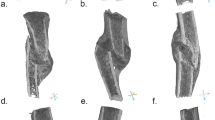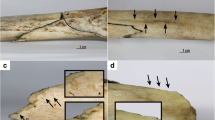Abstract
Timing of cranial trauma is challenging in forensic cases and literature on the subject is scarce. This study analysed the macroscopic fracture patterns of perimortem cranial fractures and compared them to experimentally reproduced cranial fractures on dry human craniums. The results showed nine traits associated with fresh cranial fractures: undulated margin, flake defects, peels with peel defects, fissures, crushed margins, bridge, bone scales and beveling. All the traits appear on the outer table or on the inner table of the cranium. Although not all characteristics must be present at the same time in all cranial fractures, they do define a new perimortem fracture pattern. Statistical analyses showed that six of these traits (undulated margins, flake defects, crushed margins, bone scales, fissures and peels) are distinctly related with perimortem (fresh) bone conditions. Considering the most discriminant perimortem traits, a decision-making algorithm is developed as a probabilistic approach to distinguish peri- from postmortem cranial fractures with an accuracy of 87%. This algorithm allows the forensic practitioner to incorporate more confidence during cranial trauma evaluation.












Similar content being viewed by others
References
Sauer NJ (1998) The timing of injuries and manner of death: distinguishing among antemortem, perimortem, and post-mortem trauma. In: Reichs KJ (ed) Forensic osteology: advances in the identification of human remains. Charles C. Thomas, Springfield, pp 321–332
Galtés I (2013) Estudio médico-forense del cadáver en mal estado. In: González J, Gutiérrez A (eds) X Curso de Patología Forense. Sociedad Española de Patología Forense (SEPAF). Gobierno de la Rioja, Logroño, 113–141
Tersigni-Tarrant MA, Shirley NR (2013) Forensic anthropology today. In: Tersigni-Tarrant MA, Shirley NR (eds) Forensic anthropology: an introduction. CRC Press, Florida, p 462
Christensen AM, Passalacqua NV, Bartelink EJ (2014) Forensic anthropology: current methods and practice. Academic Press, Oxford
Galloway A, Zephro L, Wedel VL (2014) Diagnostic criteria for the determination of timing and fracture mechanism. In: Wedel VL, Galloway A (eds) Broken bones. Charles C Thomas, Springfield, p 479
Symes SA, L’Abbé EN, Stull KE et al (2014) Taphonomy and the timing of bone fractures in trauma analysis. In: Pokines JT, Symes SA (eds) Manual of forensic taphonomy. CRC Press, Florida, pp 341–365
Cappella A, Amadasi A, Castoldi E, Mazzarelli D, Gaudio D, Cattaneo C (2014) The difficult task of assessing perimortem and post-mortem fractures on the skeleton: a blind text on 210 fractures of known origin. J Forensic Sci 59:1598–1601
Scheirs S, Malgosa A, Sanchez-Molina D, Ortega-Sánchez M, Velázquez-Ameijide J, Arregui-Dalmases C, Medallo-Muñiz J, Galtés I (2016) New insights in the analysis of blunt force trauma in human bones. Preliminary results. Int J Legal Med 131:867–875
Scheirs S, Hevink B, Ortega-Sánchez M, Jordana X, McGlynn H, Rodriguez-Baeza A, Malgosa A, Galtés I (2019) Intra vitam trauma pattern: changing the paradigm of forensic anthropology? Int J Legal Med 133:661–668
Reber SL, Simmons T (2015) Interpreting injury mechanisms of blunt force trauma from butterfly fracture formation. J Forensic Sci 60:1401–1411. https://doi.org/10.1111/1556-4029.12797
Saha S, Hayes WC (1976) Tensile impact properties of human compact bone. J Biomech 9:243–251. https://doi.org/10.1016/0021-9290(76)90010-5
Reich T, Gefen A (2006) Effect of trabecular bone loss on cortical strain rate during impact in an in vitro model of avian femur. Biomed Eng Online 5(45):45. https://doi.org/10.1186/1475-925X-5-45
Quinlan JR (1993) C4.5: programs for machine learning. Morgan Kaufmann Publishers, San Mateo
Li M, Zhao Z, Yu G, Zhang J (2016) Epidemiology of traumatic brain injury over the world: a systematic review. Austin Neurol Neurosci 1(2):1007
Yoganandan N, Pintar FA, Sances A, Walsh PR, Ewing CL, Thomas DJ, Snyder RG (1995) Biomechanics of skull fracture. J Neurotrauma 12:659–668. https://doi.org/10.1089/neu.1995.12.659
Hart GO (2005) Fracture pattern interpretation in the skull: differentiating blunt force from ballistics trauma using concentric fractures. J Forensic Sci 50:1276–1281
Kieser J, Taylor M, Carr D (2013) Forensic biomechanics. Wiley- Blackwell, Oxford
Berryman HE, Symes SA (1998) Recognizing gunshot and blunt cranial trauma through fracture interpretation. In: Reichs KJ (ed) Forensic osteology: advances in the identifica- tion of human remains. Charles C. Thomas, Springfield, pp 333–352
Galloway A (2014) Fracture patterns and skeletal morphology: introduction and the skull. In: Wedel VL, Galloway A (eds) Broken bones. Charles C Thomas, Springfield, pp 63–80
Porta DJ (2005) Biomechanics of impact injury. In: Rich J, Dean DE, Powers RH (eds) Forensic medicine of the lower ex- tremity: human identification and trauma analysis of the thigh, leg, and foot. Humana Press, New Jersey, pp 279–310
Galloway A, Zephro L (2005) Skeletal trauma analysis of the lower extremity. In: Rich J, Dean DE, Powers RH (eds) Forensic medicine of the lower extremity: human identification and trauma analysis of the thigh, leg, and foot. Humana Press, New Jersey, pp 253–277
Coelho L, Cardoso HFV (2013) Timing of blunt force injuries in long bones: the effects of the environment, PMI length and human surrogate model. Forensic Sci Int 233:230–237. https://doi.org/10.1016/j.forsciint.2013.09.022
Acknowledgements
Special thanks go to the technicians and personnel staff of the Institute of Legal Medicine and Forensic Sciences of Catalonia (IMLCFC) and to the staff of the medical department of the Autonomous University of Barcelona (UAB). They thank Vincent Scheirs for the design and construction of the Blunt Force Trauma Simulator. Lastly, they are very grateful to the research group of Biological Anthropology (GREAB) for the financial aid from project SGR14-1420.
Funding
This study was financially supported by the Project SGR14-1420, research group of Biological Anthropology (GREAB).
Author information
Authors and Affiliations
Corresponding author
Ethics declarations
Conflict of interest
The authors declare that there is no conflict of interest.
Ethical approval
All autopsy samples are stored in private collection at the IMLCFC, registered as a collection at the Instituto de Salud Carlos III (Reference C.0004241).
Dry samples (UAB): This study was approved by the Ethic Commission of Human and Animal Experimental Work (CEEAH) of the UAB, in compliance with the ethical regulations.
Informed consent
Informed consent was not required for this study.
Additional information
Publisher’s note
Springer Nature remains neutral with regard to jurisdictional claims in published maps and institutional affiliations.
Rights and permissions
About this article
Cite this article
Ribeiro, P., Jordana, X., Scheirs, S. et al. Distinction between perimortem and postmortem fractures in human cranial bone. Int J Legal Med 134, 1765–1774 (2020). https://doi.org/10.1007/s00414-020-02356-3
Received:
Accepted:
Published:
Issue Date:
DOI: https://doi.org/10.1007/s00414-020-02356-3




